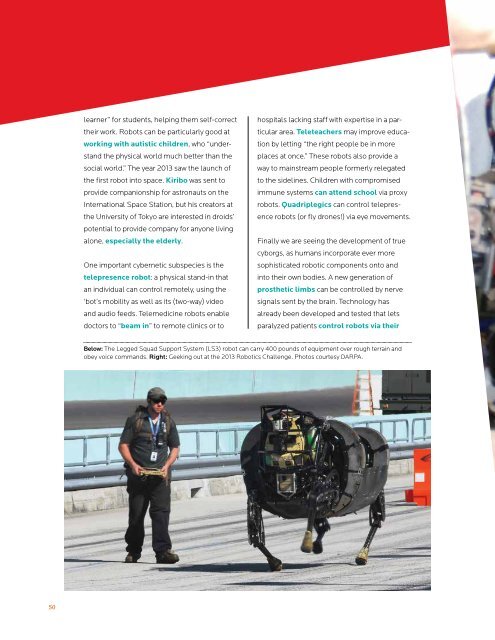1kLPuWX
1kLPuWX
1kLPuWX
Create successful ePaper yourself
Turn your PDF publications into a flip-book with our unique Google optimized e-Paper software.
learner” for students, helping them self-correct<br />
their work. Robots can be particularly good at<br />
working with autistic children, who “understand<br />
the physical world much better than the<br />
social world.” The year 2013 saw the launch of<br />
the first robot into space. Kiribo was sent to<br />
provide companionship for astronauts on the<br />
International Space Station, but his creators at<br />
the University of Tokyo are interested in droids’<br />
potential to provide company for anyone living<br />
alone, especially the elderly.<br />
One important cybernetic subspecies is the<br />
telepresence robot: a physical stand-in that<br />
an individual can control remotely, using the<br />
‘bot’s mobility as well as its (two-way) video<br />
and audio feeds. Telemedicine robots enable<br />
doctors to “beam in” to remote clinics or to<br />
hospitals lacking staff with expertise in a particular<br />
area. Teleteachers may improve education<br />
by letting “the right people be in more<br />
places at once.” These robots also provide a<br />
way to mainstream people formerly relegated<br />
to the sidelines. Children with compromised<br />
immune systems can attend school via proxy<br />
robots. Quadriplegics can control telepresence<br />
robots (or fly drones!) via eye movements.<br />
Finally we are seeing the development of true<br />
cyborgs, as humans incorporate ever more<br />
sophisticated robotic components onto and<br />
into their own bodies. A new generation of<br />
prosthetic limbs can be controlled by nerve<br />
signals sent by the brain. Technology has<br />
already been developed and tested that lets<br />
paralyzed patients control robots via their<br />
Below: The Legged Squad Support System (LS3) robot can carry 400 pounds of equipment over rough terrain and<br />
obey voice commands. Right: Geeking out at the 2013 Robotics Challenge. Photos courtesy DARPA.<br />
50


